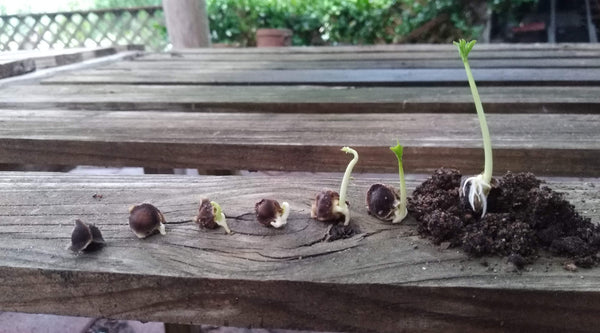Growing Guide

Miracle Garden Growing Guide for Moringa Oleifera from Seeds
Soak seeds in water for 24-36 hours. Then, remove seeds from water and spread them across a plate or tray lined with wet paper towel. Cover seeds with another layer of damp paper towel. You can also use a sprouting tray and cover set with a little water, but best not to keep seeds submerged in soaking water after 36 hours.
Keep paper towels damp for 5 to 12 days. Trays can be left indoors or outside but best in between the temperatures of 76 to 90 degrees Fahrenheit with airflow and some exposure to light or in partial shade if outside. Replace paper towels at the first sign of mold or spoilage.
Moringa seeds typically will germinate within 12 to 15 days. Dispose or compost seeds after 15 days if there are no signs of any sprouting.
The seeds will grow two main sprouts out of the protective brown husk during the germination process. One sprout will grow downward, away from light to become the root. Another sprout will grow toward light to become the main trunk and first leaves of the moringa tree.
After you can clearly distinguish an upward sprout (with or without the beginnings of leaves) you can transfer your seed to a pot or in ground in warm weather. Be extra careful to position the seed with the trunk sprout pointing up and root sprout under the soil, and do not place the seed upside down.
Do not completely bury germinated seeds. Our seedlings in pots are sowed only 1 to 2 inches deep in the soil. You can plant them deeper as they grow taller, when moving into an in ground location or transferring into a larger pot. When growing as a crop or natural barrier fence, spacing as little as 4 to 6 inches can be used.
Best to use partially sandy soil and keep well irrigated. Moringa is susceptible to root rot. Never keep in soaking wet soil, but prevent the soil from becoming bone dry, as young seedlings cannot tolerate drought as well as established young trees with harder bark.
In Central Texas, seedlings can grow up to 12 to 15+ feet tall in a single summer. Moringa trees naturally grow slender and tall with one main trunk and branches, leaves, flowers, and bean pods at the very top. You can create “dwarf moringa” by pruning your plant to any desired height and as short as 8 to 10 inches tall. Green tops and new branches typically establish themselves again within 35 to 60 days after cutting trunks. You may also try to propagate cuttings after pruning, but it requires more experience than the typical recreational or novice gardener garners.
In most of Texas, moringa trees will go dormant in the late fall through winter. You can leave tall trees as is or prune down the trunk to a few inches when the dormant season arrives. In areas experiencing frost, be sure to mulch or blanket cover if freezes are expected. Typically, we see signs of life again in late-April to mid-May, when the climate is consistently sunny and warm, over 75 to 80 degrees.
Moringa is typically resistant to most pests, but in times of need, any sort of insect from termites, caterpillars, to spiders may use moringa as food or shelter. Cattle, sheep, pigs, deer, horses, and goats may eat seedlings, pods, and leaves, as well. It is actually nutritional and safe animal fodder.
Fresh leaves have a mild spicy taste similar to arugula and radish. Leaves and new tender branches can be enjoyed fresh in salad, omelets, soup, stir-frys, smoothies, or whatever you can imagine. For longevity of use, you can air or sun dry leaves after rinsing with water.
We wish you happy and healthy adventures with your moringa!